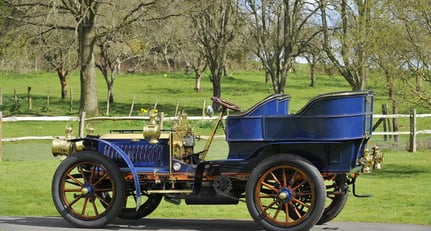1902 De Dietrich 16 HP
-
Year of manufacture1902
-
Chassis number1036
-
Engine number558
-
Lot number329
-
DriveLHD
-
ConditionUsed
-
Number of seats2
-
Location

-
Exterior colourOther
-
Drivetrain2wd
-
Fuel typePetrol
Description
Ex-Lord Iveagh, Francis Hutton-Stott
Offered from the Michael Banfield Collection
1902 De Dietrich 16-hp "Paris-Vienna" Rear-Entrance Tonneau
Registration no. A 2101
Chassis no. 1036
Engine no. 558
Few cars can have come to light as spectacularly as this magnificent veteran, which was discovered during World War Two when a German bomb demolished the stable in which it had been sleeping on blocks since 1912. With just four owners from new, this powerful four-cylinder 4078cc De Dietrich is identical in specification to the works racers built for the 1902 Paris-Vienna Race.
"Same as you can buy" has always been a potent sales tool for motor makers, who realise that competing in motor sport with examples of their production models is excellent advertising. That was as true in 1902 as it is today, and the excitement engendered by that year's Paris-Vienna race, which was run concurrently with the Gordon Bennett Trophy, saw De Dietrich of Lunéville (Lorraine) enter four of their new 16-hp cars, which were built under a licence signed earlier that year with Turcat-Méry of Marseille.
The roots of the De Dietrich company lay in Alsace, where in 1681 the burgomaster Dominique de Dietrich had signed the act that made Strasbourg a French city. Soon after, the de Dietrichs acquired an ironworks at Niederbronn, 26 miles north of Strasbourg, to establish a metallurgical business that by the mid-19th Century had become a specialised manufacturer of railway wheels, axles and rails.
However, after the Franco-Prussian War of 1870-71, Alsace and part of the neighbouring province of Lorraine had been annexed by the victorious Germans, who instituted protectionist customs duties that prejudiced sales to the firm's main customers in France. To counter this, in 1879 De Dietrich set up a French subsidiary in Lunéville, a border town that attracted former citizens of the annexed territories who had chosen exile rather than adopt German nationality. The subsidiary became a separate company in late 1897.
Earlier in that year De Dietrich of Lunéville had acquired the licence to build cars designed by Amédée Bollée, but these idiosyncratic flat-twin automobiles had become thoroughly outmoded by 1901. Board member Baron Adrien de Türckheim, whose father had married into the de Dietrich family and ran the Lunéville factory, looked around for an up-to-date successor. Early in 1902, Adrien de Türckheim visited Nice probably for the Automobile Meeting at the beginning of April and saw an unfamiliar car that interested him. It was a Turcat-Méry driven by the crack driver, Rougier, and the influential journalist Paul Mayan introduced Adrien de Türckheim to its makers, the cousins Léon Turcat and Simon Méry. They had built a car as early as 1896 and established a manufacturing company in their home town of Marseille in 1899. Their latest models had been built for the proposed 418-mile Nice-Abazzia contest, in which they were thought likely to "prove one of the revelations of the coming race", but the last-minute prohibition of the contest gave them no chance to prove their mettle.
De Türckheim was taken for a drive in one of the new Turcat-Mérys, and was so impressed by its design that he took out a licence to build Turcat-Mérys under the De Dietrich name at Lunéville (around the same time Niederbronn acquired the services of a mercurial young Italian designer named Ettore Bugatti whose designs proved more troublesome).
In its report on the Nice meeting, The Autocar disclosed that a Turcat-Méry "had been disposed of to Mr Guinness, the famous brewer of Dublin". Describing the new Turcat-Mérys as "really splendid vehicles", the magazine added, "We were informed that the car has been timed to run at the rate of 52 to 55 mph on good level roads. It is certainly very fast, and we were given an opportunity of trying the vehicle by a run through Nice and down to the sea front, when the motor showed a great elasticity and the speeds were changed promptly with perfect ease."
The Autocar waxed lyrical about the 16-hp De Dietrich (Turcat-Méry system) when the first examples arrived in Britain in the autumn of 1902: "These fine vehicles are the output of the great firm of De Dietrich and Company, of Lunéville, a firm of rolling stock and locomotive builders whose name is a household word in engineering circles on the Continent. As now turned out, the De Dietrich carriage made its first bow to the public in the recent Paris-Vienna race, when three 16-hp cars faced the starter, and all performed in a manner so creditable as to astonish automobilists in general and the older constructors of automobiles in particular. It is seldom, if ever, that racing automobiles have done so well on first appearance. Although combining many of the best points of the latest Panhard and Mercedes construction, the new car nevertheless exhibits much originality in detail."
An early customer for this newcomer to the British market was the Hon Rupert Guinness, heir to the Earl of Iveagh, who in the spring of 1903 took delivery of this 16-hp De Dietrich from the Burlington Carriage Company of Oxford Street, London, who imported bare chassis from Lunéville and fitted them with their own coachwork. Former owner Francis Hutton-Stott declared in 1953 that this was the chassis ordered from Turcat-Méry in April 1902 by "Mr Guinness the brewer". Presumably the fulfilment of the order was delayed because of the time needed to establish production at Lunéville.
The handsome Burlington four-seater body fitted to the Guinness car had a detachable tonneau section that could be removed to convert it into a racing two-seater. It was displayed at the March 1903 Cordingley Exhibition in the Agricultural Hall, Islington, where The Autocar described it as "one of the finest examples of body building in the show" (but attributed it to the wrong coachbuilder, prompting an abject apology in the following issue correctly crediting Burlington for "the exquisite turnout of the whole vehicle", accompanied by a photograph of the Hon Rupert Guinness at the wheel).
In 1903, when a canopy and windscreen were fitted, the De Dietrich was used as the wedding car for the Hon Rupert and his bride Gwendolen, daughter of the 4th Earl of Onslow. Three years later, he used the De Dietrich, fitted with a closed landaulet body, in his campaign when running as Unionist candidate for the East London Haggerston constituency.
But in 1912 the De Dietrich, fitted again with its original tonneau body, was driven into the stable at the Hon Rupert's home, Pyrford Court at Woking in Surrey, and put up on blocks. There it would stay until 1940, when a bomb dropped during a German air raid demolished the stable. The car was undamaged and was moved to the Guinness Dairy Farm in Old Woking, where it stood out in the open, "a roosting place for the birds of the air and a plaything for the local brats".
Then in March 1942 the ever-vigilant Bill Boddy, editor of Motor Sport, published a list of 50 veteran, Edwardian and vintage cars most at risk from the national scrap metal drive. Included in that list was "DE DIETRICH, Type 8, four-cylinder Roi de Belge, rough, no tyres, big engine, chain drive (Surrey)."
Veteran Car Club committee member Francis Hutton-Stott decided it was worth expending what little of the wartime "basic" petrol ration remained in the tank of his Morgan 4/4 to take a look at the car and realised from its automatic inlet valves, gilled-tube radiator and flitch-plated wooden chassis that it could be no later than 1903 in date. Lord Iveagh (the Hon Rupert had succeeded to the title in 1927) was not at home, but Hutton-Stott located the Earl's chauffeur, who recommended writing to Lord Iveagh and asking if he would dispose of the car to a good home. The Earl responded that he would be happy to give Hutton-Stott the car without charge if he could arrange transport.
A breakdown truck was quickly arranged, and the car was towed to Hutton-Stott's home, where in due course a "firing-up" party was arranged with luminaries of the old car world John Bolster, "Bunny" Tubbs, Laurence Pomeroy and Cecil "Sam" Clutton in attendance. Amazingly, after lying idle for 30 years, the engine fired almost immediately and kept running. Though the clutch was inoperative and the gear lever was missing, Clutton engaged second gear with a screwdriver and was push-started down the drive. Fortunately the clutch freed in time to avert disaster, and the car circled a flowerbed in a cloud of smoke "touching a speed that may have been 25 mph but looked three times as fast".
Restoration began in 1946, when the car was completely rebuilt by Teddy Pilmore-Bedford at Catford and Leslie Paget at the Wimbledon Motor Works, making its debut at the VCC Oxford Rally in May 1950; it successfully completed its first Brighton Run in November that year.
In Hutton-Stott's ownership, the De Dietrich took part in several Brighton Runs, took part in Edwardian races and parades at Silverstone and Castle Combe, and made fastest time of the day in the 1954 VCC Bexhill speed trials before going on display in the Montagu Motor Museum at Beaulieu.
Hutton-Stott retained the car which he believed had been a reserve car for the works team in the Paris-Vienna race until 1965, when it was sold to fellow enthusiast Frederick Michael Willcock of Pulborough, Sussex. Michael Banfield acquired the car in November 1970 at a Norman Cole auction at Alexandra Palace. In his ownership the car has been comprehensively restored, and is now resplendent in royal blue, and sports a magnificent pair of Polkey paraffin headlamps and rare matching sidelamps.
This rare and desirable veteran comes with a large history file that warrants closer inspection including copies of The Motor September 1942 and 1944, a buff log book, some receipts, a V5 and correspondence while in the custodianship of Michael Willcock. It is ready for this year's London to Brighton Run and application has been made through Bonhams for an entry.
As a powerful four-cylinder chain-drive four-seater with a fantastic provenance, this car ticks every Brighton Run box. It is, as Bill Boddy wrote in 1961, "a splendid reminder both of the now legendary town-to-town races held at the turn of the century and of the sort of motor car in which the more sporting members of the aristocracy liked to burn the roads in the early days of automobilism."

























